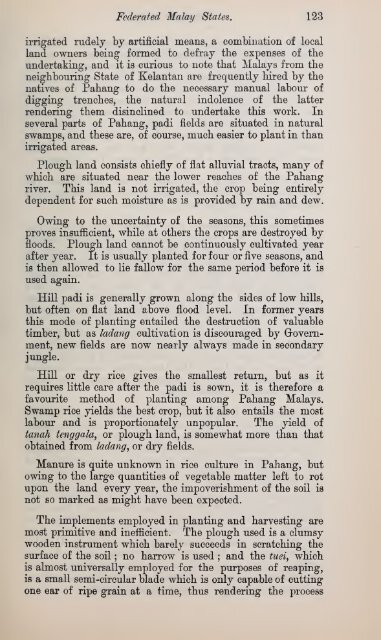Handbook of the federated Malay states - Sabrizain.org
Handbook of the federated Malay states - Sabrizain.org
Handbook of the federated Malay states - Sabrizain.org
You also want an ePaper? Increase the reach of your titles
YUMPU automatically turns print PDFs into web optimized ePapers that Google loves.
Federated <strong>Malay</strong> States. 123<br />
irrigated rudely by artificial means, a combination <strong>of</strong> local<br />
land owners being formed to defray <strong>the</strong> expenses <strong>of</strong> <strong>the</strong><br />
undertaking, and it is curious to note that <strong>Malay</strong>s from <strong>the</strong><br />
neighbouring State <strong>of</strong> Kelantan are frequently hired by <strong>the</strong><br />
natives <strong>of</strong> Pahang to do <strong>the</strong> necessary manual labour <strong>of</strong><br />
digging trenches, <strong>the</strong> natural indolence <strong>of</strong> <strong>the</strong> latter<br />
rendering <strong>the</strong>m disinclined to undertake this work. In<br />
several parts <strong>of</strong> Pahang, padi fields are situated in natural<br />
swamps, and <strong>the</strong>se are, <strong>of</strong> course, much easier to plant in than<br />
irrigated areas.<br />
Plough land consists chiefly <strong>of</strong> flat alluvial tracts, many <strong>of</strong><br />
which are situated near <strong>the</strong> lower reaches <strong>of</strong> <strong>the</strong> Pahang<br />
river. This land is not irrigated, <strong>the</strong> crop being entirely<br />
dependent for such moisture as is provided by rain and dew.<br />
Owing to <strong>the</strong> uncertainty <strong>of</strong> <strong>the</strong> seasons, this sometimes<br />
proves insufficient, while at o<strong>the</strong>rs <strong>the</strong> crops are destroyed by<br />
floods. Plough land cannot be continuously cultivated year<br />
after year. It is usually planted for four or five seasons, and<br />
is <strong>the</strong>n allowed to lie fallow for <strong>the</strong> same period before it is<br />
used again.<br />
Hill padi is generally grown along <strong>the</strong> sides <strong>of</strong> low hills,<br />
but <strong>of</strong>ten on flat land above flood level. In former years<br />
this mode <strong>of</strong> planting entailed <strong>the</strong> destruction <strong>of</strong> valuable<br />
timber, but as ladang cultivation is discouraged by Grovernment,<br />
new fields are now nearly always made in secondary<br />
jungle.<br />
Hill or dry rice gives <strong>the</strong> smallest return, but as it<br />
requires little care after <strong>the</strong> padi is sown, it is <strong>the</strong>refore a<br />
favourite method <strong>of</strong> planting among Pahang <strong>Malay</strong>s.<br />
Swamp rice yields <strong>the</strong> best crop, but it also entails <strong>the</strong> most<br />
labour and is proportionately unpopular. The yield <strong>of</strong><br />
tanah tenggala, or plough land, is somewhat more than that<br />
obtained from ladang^ or dry fields.<br />
Manure is quite unknown in rice culture in Pahang, but<br />
owing to <strong>the</strong> large quantities <strong>of</strong> vegetable matter left to rot<br />
upon <strong>the</strong> land every year, <strong>the</strong> impoverishment <strong>of</strong> <strong>the</strong> soil is<br />
not so marked as might have been expected.<br />
The implements employed in planting and harvesting are<br />
most primitive and inefficient. The plough used is a clumsy<br />
wooden instrument which barely succeeds in scratching <strong>the</strong><br />
surface <strong>of</strong> <strong>the</strong> soil ; no harrow is used ; and <strong>the</strong> tuei, which<br />
is almost universally employed for <strong>the</strong> purposes <strong>of</strong> reaping,<br />
is a small semi-circular blade which is only capable <strong>of</strong> cutting<br />
one ear <strong>of</strong> ripe grain at a time, thus rendering <strong>the</strong> process

















